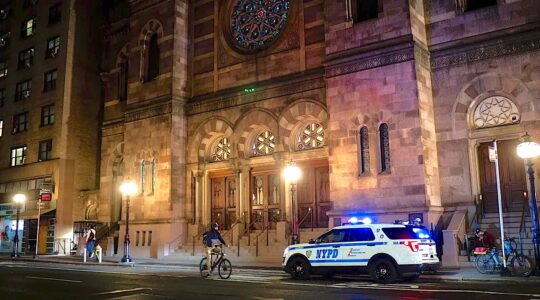Nonfiction
A third memoir in Helen Epstein’s trilogy about growing us as the daughter of Holocaust survivors, “The Long Half-Lives of Love and Trauma,” by Helen Epstein (Plunkett Lake) probes relationships, trauma, love and memory itself. (February)
In “Pogrom: Kishinev and the Tilt of History,” historian Steven J. Zipperstein balances the 1903 Kishinev Pogrom as both enduring symbol and awful reality. More than a century after Bialik’s monumental poem “In the City of Killing” blamed the Jews for their passivity, Zipperstein closely examines the Pogrom’s timeline and shows the varied responses of the Jewish community, from demanding police action to hiding to fighting back. (March)
A dual autobiography, “Hunting the Truth,” by Beate and Serge Klarsfeld (Farrar, Straus & Giroux) is the candid story of this couple’s determination and experience in bringing Nazis to justice over 50 years, including their role in assisting in the capture of Klaus Barbie and others. (March)
Illustrated with photographs and artwork, “The Warsaw Ghetto in American Art and Culture,” by Samantha Baskind (Penn State) demonstrates how the uprising in the Warsaw Ghetto on the eve of Passover in 1943 has captured the American cultural imagination, as seen in literary works, art, theater, film and poetry, including the work of Leon Uris, Roman Polanski, Samuel Bak and Charles Reznikoff. (March)
“Thou Shalt Innovate: How Israeli Ingenuity Repairs the World,” by Avi Jorisch (Gefen) includes accounts of how Israeli technological prowess helps Israel and also helps solve problems around the world. (March)
“Voice Lessons for Parents: What to Say, How to Say It, and When to Listen” by Wendy Mogel (Scribner) is a practical guide to changing the nature of conversations — and relationships — between parents and kids, through language, understanding, respect and open-heartedness. (April).
In “A Rich Brew: How Cafes Created Modern Jewish Culture” (NYU), Shachar Pinsker draws on literary and historical sources to portray the institution of the coffeehouse in the 19th and 20th centuries as a Jewish space, tied to urbanization, creativity, culture, debate and Jewish identity. Many Jews owned cafes, others frequented them, whether to write, socialize or connect with Jews and non-Jews. (May)
Through a series of letters, the American-born Israeli journalist and author Yossi Klein Halevi directly addresses an anonymous Palestinian neighbor in “Letter to My Palestinian Neighbor” (HarperCollins) in this attempt to illuminate and break the impasse between Israelis and Palestinians. He writes empathetically about Palestinian suffering, as he tries to explain the conflict through Israeli eyes. (May)
“Deposition 1940 – 1944” by Leon Werth, edited and translated by Daniel Ball (Oxford University Press) is an uncommon work of Holocaust testimony in the form of a diary by a Jewish writer in Nazi-occupied Paris, who wrote about daily life in the mountain village where he was hiding, noting what people were saying and how Vichy and the Occupation affected their lives. (May)
A new addition to the Jewish Lives series, Lillian Federman’s “Harvey Milk: His Lives and Death” (Yale) portrays the gay man who was shot to death less than a year after his election to the San Francisco Board of Supervisors. (May)
“Radical Jewish Feminism: Voices from the Women’s Liberation Movement” by Joyce Antler (NYU) unfolds untold stories of the struggles and achievements of Jewish women, through the narratives of 40 activists. (May)
Support the New York Jewish Week
Our nonprofit newsroom depends on readers like you. Make a donation now to support independent Jewish journalism in New York.
Bowie’s “Piano Man: The Life of Mike Garson” by Clifford Slapper (Blackbeat) is a biography of the Brooklyn-born musician who appeared most frequently with David Bowie onstage and on recordings.
Fiction
Told from a military jail, “Sadness is a White Bird” by Moriel Rothman-Zecher (Atria) is the story of a young man who moves back to Israel and joins the army, and along the way befriends a pair of Palestinian twins who change the course of his life. (February)
A multi-generational novel, “The Last Watchman of Cairo” by Michael David Lukas (Spiegel & Grau) tells of a student from Berkeley, the son of a Jewish mother and Muslim father, pulled into a mystery as he tries to understand a gift left by his father, the son of generations of watchmen at Cairo’s Ibn Ezra Synagogue. (April)
“The Diamond Setter” by Moshe Sakal, translated from the Hebrew by Jessica Cohen (Other Press), is inspired by actual events, centering on a rare, multifaceted diamond, that touches lives, mysteries and love entanglements across centuries and borders. (March)
“Our Lady of the Prairie” by Thisbe Nissen (Houghton Mifflin Harcourt) is a novel of marriage, midlife and motherhood, about the lives we live and the stories we create, with many themes, including the Holocaust. (February)
An illustrated debut novel for young readers, “What the Night Sings” by Vesper Stamper (Knopf) is the story of a teenage Holocaust survivor who loses all of her family. The novel begins with her liberation and follows her path to rebuilding her life. (February)
“The Cloister” by James Carroll (Talese/Doubleday) is a historical novel about faith and doubt, with deep conversations between a Catholic priest and a French Jewish woman in New York City in the middle of the last century, touching on the Holocaust and on the Crusades. (March)
The story behind “Memento Park: A Novel by Mark Sarvas” (Farrar, Straus and Giroux) is ignited when a painting looted during the Holocaust in Hungary is recovered, and a son learns about his father and his family history, his own Jewish identity, the life of the painter and the power of art. (March)
“Holy Ceremony” by Harry Nykanen (Bitter Lemon Press) involves another case for Detective Ariel Kafka, one of two Jewish cops in all of Helsinki. He is called on to investigate the killing of woman whose body is scrawled over with religious texts. (March)
Peter Golden’s “Nothing is Forgotten” (Simon & Schuster) opens in South Orange, N.J., in the 1950s, and is the story of a family of Russian Jews. Michael, also known as Mikhail, Mishka and Misha, launches a radio station from his grandmother’s candy store, which becomes a local hit and is also heard in small Soviet cities. A murder leads to a search through Europe and his family history, showing the very long shadow of World War II (April).
“The Magnificent Esme Wells” is the narrator of Adrienne Sharp’s novel (Harper), set in the 1930s and 1940s in Hollywood and Las Vegas, mixing fictional real-life movie stars and mobsters. At 20, Esme is the worldly daughter of a small-time gangster connected to Bugsy Siegel, and her mother is a wannabe showgirl. It’s a story of big dreams, love and loss, with a bit of noir. (April)
“Gateway to the Moon” by Mary Morris (Talese/Doubleday) begins in a desert town in New Mexico, and stretches back over the centuries, tracing Sephardic Jews from the Spanish Inquisition to the present, through a family and place with hidden stories. (April)
Support the New York Jewish Week
Our nonprofit newsroom depends on readers like you. Make a donation now to support independent Jewish journalism in New York.
A comic novel about death, “Tombstone: Not a Western by Francis Levy” (Black Rose) is about a New York couple finding their way through the funeral business to their best endings. (April)
A literary thriller, “The Mandela Plot” by Kenneth Bonnert (Houghton Mifflin Harcourt) involves a South African Jewish family in the apartheid era. This is also a coming-of-age story for the son of a scrap dealer whose life changes when an American exchange student arrives in their home. (May)
The Guatemalan-born narrator of Eduardo Halfon’s novel “Mourning,” translated by Lisa Dillman and Daniel Hahn (Bellevue Literary Press), searches for his mother’s Jewish roots in Poland and his father’s Lebanese Jewish family, tracking silence, loss, memory and identity related to a long-ago mysterious drowning of an uncle. (May)
“The Optimistic Decade” by Heather Abel (Algonquin) is a story of America in the 1980s and ’90s, when idealism goes awry in a Colorado mountain town. (May)
Set in Coney Island in 1972, “The Kabbalah Master: A Novel” by Perle Besserman (Monkfish) is the tale of a divorced mother of two who works for a charismatic, mysterious and mystically-inclined rabbi who fails to return after a trip to Israel. The author sees connection between the novel and the current women’s movement as it is exposing male abuse of power. (May)
A dark thriller, “Last Instructions” by Nir Hezroni, translated by Steven Cohen (St. Martin’s), continues the story of the former Israeli secret service operative begun in “Three Envelopes,” with a behind-the-scenes look at high-level intelligence operations. (May)
A debut novel, “My Mother’s Son” by David Hirshberg (Fig Tree Books) is told by a radio host looking back on coming of age in Boston in the years following World War II, amidst baseball, politics, the Korean War and the lingering effects of the Holocaust. Hirshberg is the pseudonym of an entrepreneur who prefers to keep his identity private.
The New York Jewish Week brings you the stories behind the headlines, keeping you connected to Jewish life in New York. Help sustain the reporting you trust by donating today.




